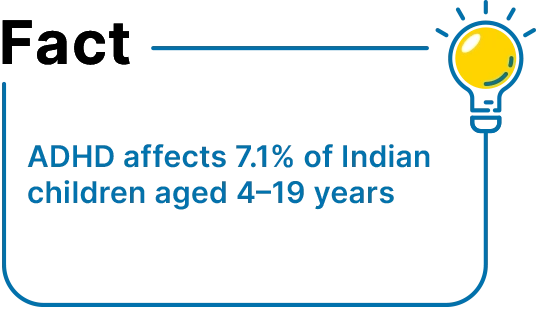ADHD - Natural, Personalised & Gentle Care for Kids
Supporting Attention, Behaviour & Learning Abilities with homeopathy
Book your Appointment
ADHD is a neurodevelopmental disorder marked by inattention, hyperactivity, and impulsivity that often impacts school performance, relationships, and emotional health. Symptoms can persist into adulthood if untreated
A study published on PubMed, based on a review of over 588 studies and 3.2 million participants, found that ADHD affects 8% of children and adolescents globally, with boys (10%) nearly twice as likely as girls (5%) to be diagnosed. The inattentive type is the most common, highlighting the importance of early intervention
At Dr Batra’s®, we offer a root‑cause homeopathic approach: tailored remedies, behavioural guidance, and family support. This helps children focus, build self‑esteem, and navigate daily challenges naturally
With over 40 years of healing experience, Dr Batra’s® combines homeopathy, psychology, and family‑centred care for lasting results:
Child‑Specific Homeopathy
Remedies are selected based on attention patterns, temperament, and stress factors
Expert Pediatric & Mental‑Health Team
350+ doctors trained to support neuro‑development, learning, and behaviour
Trusted by Families
15 lakh+ patients and ongoing care across 200+ clinics
Customised Support Plans
Includes behaviour coaching, concentration techniques, and parent training
Progress Tracking
Focus scales, academic feedback, and emotional‑well‑being reviews
Outcome‑Based Results
Regular progress reports, doctor observations, and testimonials ensure accountability
Genetic Predisposition
High heritability and family history
Neurodevelopmental Factors
Brain signalling differences (dopamine, norepinephrine)
Environmental Influences
Early stress, toxin exposure
Behavioural Triggers
Sleep issues, screen-time, inconsistent routines
Difficulty sustaining focus or following instructions
Impulsive actions, frequent interruptions, or blurting out
Restlessness or fidgeting
Academic struggles or poor task completion
Emotional outbursts, low self-esteem, or social difficulties
A case study of Dr Batra’s® published in the International Journal of AYUSH highlights a 3-year-old with delayed speech and ADHD symptoms treated at Dr Batra’s®. Homeopathy improved both behavioural and emotional symptoms, demonstrating the holistic impact of personalised homeopathic care

Structured Routine
Set fixed wake-up, meal, and study times.
DIY: Use visual planners to guide kids
Balanced Diet
Focus on whole foods; avoid sugar and junk.
DIY: Let kids help make healthy snacks
Regular Activity
Encourage daily play, sports, or dance.
DIY: Use a “movement jar” with fun tasks
Sleep Hygiene
Keep a fixed bedtime; limit screens before sleep.
DIY: Try reading or soft music before bed
Parental Support
Praise good behavior and use reward charts.
DIY: Create an “achievement board” for motivation
| Treatment Feature | Homeopathy | Conventional |
|---|---|---|
| Treats ADHD from the root | ||
| Safe for children | ||
| Addresses emotional & behavioural health | ||
| Non-pharmacological | ||
| Long-term stabilisation | ||
| Personalised family-centred care |
Early ADHD care helps prevent academic decline, social rejection, risky behaviour, and comorbid issues like anxiety or substance misuse. Homeopathy offers a gentle, supportive path to help your child achieve balance, emotional wellness, and academic success, without harsh medications

Attention Deficit Hyperactivity Disorder (ADHD) is a neurodevelopmental condition that affects attention, impulse control, and activity levels in children. It can interfere with learning, relationships, and behaviour. Common signs include trouble focusing, restlessness, acting without thinking, and difficulty following instructions or sitting still
Yes. Homeopathy treats ADHD by targeting the child’s unique symptoms, like impulsivity, hyperactivity, or inattention, while also addressing emotional triggers. It offers a safe, non-addictive, side-effect-free alternative that helps improve behaviour, focus, and emotional regulation through long-term, individualised treatment plans
ADHD can be treated at any age once symptoms become noticeable and interfere with the child’s development or daily routine. Early intervention, especially during the preschool or early school years, improves academics, behaviour, and emotional wellbeing outcomes
No. ADHD is not just behavioural, it stems from a mix of genetic, neurological, and environmental factors. Children with ADHD may have underlying emotional or cognitive challenges. Homeopathy considers the whole picture, physical, mental, and emotional, to find the root cause and tailor the treatment
Parents can help by setting daily routines, encouraging physical play, offering balanced nutrition, ensuring good sleep hygiene, and using calm, consistent discipline. Emotional support and praise for effort are essential. These, combined with expert homeopathic care, create a strong foundation for progress